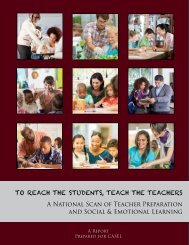Future Ready Learning
7m3sdJ
7m3sdJ
You also want an ePaper? Increase the reach of your titles
YUMPU automatically turns print PDFs into web optimized ePapers that Google loves.
among middle school students with (or<br />
without) visual impairments. The product<br />
includes a haptic sensing controller device<br />
to provide real-time tactile, visual, and audio<br />
feedback. See video.<br />
• Filament Games developed the Gameenhanced<br />
Interactive Life Science suite of<br />
learning games to introduce middle school<br />
students to key scientific concepts and<br />
practices in the life sciences. These games,<br />
aligned to UDL, provide students with<br />
multiple means of representation, expression,<br />
and engagement and provide assistive<br />
features such as in-game glossaries and<br />
optional voice-over for all in-game text. See<br />
video.<br />
• Institute for Disabilities Research and Training developed the myASL Quizmaker to provide<br />
Web-based assessments for deaf or hard of hearing students who use ASL. This<br />
product provides automatic ASL graphic and video translations for students; enables<br />
teachers to create customized tests, exams, and quizzes that are scored automatically;<br />
and provides teacher reports with grades and corrected quizzes. See video.<br />
DESIGN IN PRACTICE: INDIANA SCHOOL DISTRICT ADOPTS UDL FOR ALL STUDENTS<br />
Bartholomew Consolidated School Corporation is a public school district in Columbus,<br />
Indiana, serving approximately 12,000 students. The student population consists of 13<br />
percent in special education, 50 percent receive free or reduced-price lunch, and more<br />
than 54 languages are spoken. UDL has been helpful as a decision-making tool in the<br />
deployment of technologies such as computers and other networked devices. The UDL<br />
guidelines help educators determine what strategies, accessible technologies, and<br />
teaching methods will enable all students to achieve lesson goals.<br />
In one instance, a social studies teacher held an online discussion during a presidential<br />
debate. Realizing that some students were not taking part in class discussions, the<br />
teacher used technology to provide multiple means of representation, expression, and<br />
engagement. Some students who were reluctant to speak up in a face-to-face setting<br />
felt safe to do so online, becoming engaged participants in the class discussion.<br />
Since they adopted a universal design approach, graduation rates increased by 8 percent<br />
for general education students and 22 percent for special education students. Also,<br />
the number of students taking and passing Advanced Placement tests has increased.<br />
Physical Spaces and Technology-Enabled <strong>Learning</strong><br />
Blended learning and other models of learning enabled by technology require educators to<br />
rethink how they organize physical spaces to facilitate best collaborative learning using digital<br />
tools. Considerations include the following:<br />
• Are the design and layout of the physical space dynamic and flexible enough to facilitate<br />
the technology-enabled learning models and practices selected? Can a space in which an<br />
educator delivers whole-class instruction also be shifted to facilitate individual online<br />
practice and research?<br />
• Do the physical spaces align in their ability to facilitate individual and collaborative work?<br />
When practices such as project-based learning require students to be working together<br />
OFFICE OF Educational Technology<br />
20



